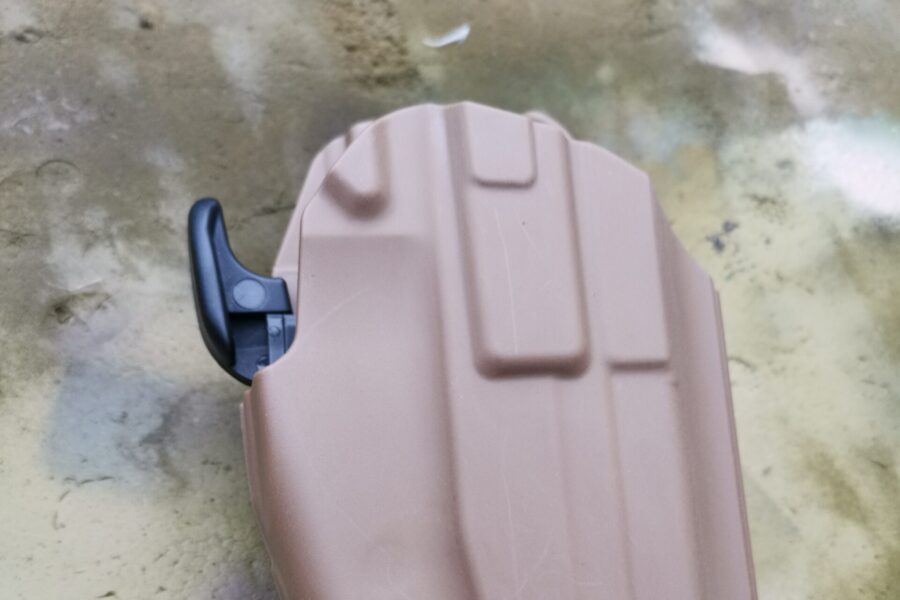A quick tour through holster placement
With the COVID-19 lockdowns slowly drawing to an end, airsoft communities left and right are seeing an increase in new members. This is often goes paired with numerous questions about gun purchases, and accessories like slings, holsters and water containers.
In this article I’d like to give you a quick tour through the different holster placements and what properties to consider when picking one. Brands and retainer-mechanisms aside, in both the law enforcement and military domain you’ll be seeing these categories:
- Waistband holsters (both inside and out)
- Shoulder & sling holsters
- Drop-leg holsters
- Chest holsters
Rather than picking what you find most attractive, try and take ergonomics and safety for each type of holster in regard.
Waistband holsters

This is my favorite type of holster placement. It has fallen out of grace in the military and special police units because they tend to interfere with either plate carriers or the attachments on the plate carriers (which is a safety consideration!). As opposed to drop-leg holsters, these will float above the point at which your arm extends when resting. This is an important factor for police and military: as regular police officers will generally not walk around with a round chambered, this holster placement gives them a speed advantage as they can chamber a round during their draw. For military purposes this isn’t required as a round is usually chambered when final preparations for deployment are made.
- Ergonomic for quick-draw with pistol that has no round chambered
- Most all-round ergonomic option for concealed carry.
- Airsoft is played as militaristic game, you usually start with bb’s chambered.
- Plate carriers will mostly get in the way of drawing.
Shoulder & sling holsters
For you snipers out there, this is a surprisingly good fit with concealment suits like leafsuits, full ghillies and sniper ghillies. There are other scenarios where this type of holster placement is favored, and to my knowledge all of them do so because it is so easily concealed (though in terms of retention this is as protected as it gets). This placement has its drawbacks. For one, an ergonomic fast draw is pretty much out of the question, and more than the waistband holster this will definitely get in the way of your plate carrier and pouches.
- Easy concealable, even for longer pistols.
- Will not get in the way with pretty much any sort of movement.
- Slow draw, holster motion is not intuitive.
- Not an option for operators with plate carriers.
Drop-leg holsters
By far the most popular on airsoft fields as it is favored by both military and special police units. In terms of drawing, it is fast and will definitely not get in the way of your plate carrier. It will serve you well as long as you’re upright. Ironically, there are downsides to it in terms of drawing: when you are operating a different armament, the distance between your shooting hand and the holster is about as far as it can be (ankle holsters not taken into account!).
- Leaves room for a plate carrier and other gear.
- Intuitive draw and holster: full arm extension is where your pistol will be.
- Slow draw as your hand requires large travel.
- Not ergonomic when crawling or rolling.
Chest holsters
A modern take on the shoulder and sling holsters, chest holsters can put your sidearm in the same vicinity but not get in the way of your plate carrier. In fact, it would be mounted right on top of it. When placed on the shooting-hand side of the plate carrier with the grip just past your sternum, it will allow for a very fast draw when your main armament cannot be used. While in action it is by far the fastest placement type to draw from, while idle it is probably one of the slowest unless you require chambering a round (which is where some speed can be won back). It is said that this type of placement is favored by operators mounted in vehicles, but it depends on the vehicle. Close Protection Officers will prefer a sling holster when a dresscode prevents them from wearing a plate carrier, armored infantry divisions are rarely seen with this type of placement as the holster can grab on to the seatbelt, preventing a swift disembark. It goes without saying that being prone for extended periods is not comfortable with this type of placement.
- Fast and intuitive drawing and holstering in action.
- One less piece of equipment to gear up with as it’s on your chest rig.
- Uncomfortable while prone.
- Might latch onto seatbelts, slings, rappelling ropes, etc.
Types of operators and their choices
So by now it should go without saying that the criteria for a holster should be more than “man that’s cool” and “military does it”. Not to slam the military on their methods and tactics, but to imitate them will only take your halfway through the game as the context in which the military engages targets differs a lot more from airsoft than you’d think. There will be more on that in the starter chapters of my book series.
Given the differences, look at the physical position you adopt and imagine what holster placement suits you best. It should be a comfortable one, not aesthetically pleasing (unless that’s the main thing your’re going for). For concealed snipers, this will most likely be a shoulder or sling holster, for CQB ops you will likely find chest holsters more ergonomic. Drop-leg holsters are probably the better pick when you’re going to have to do your rounds on all of these areas in a single operation like infantry.




